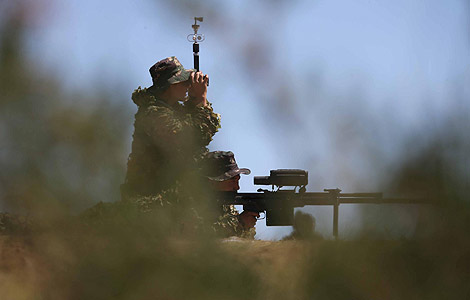Nations unite to help tigers
Updated: 2013-07-30 02:14
By Yang Yao in Kunming (China Daily)
|
|||||||||||
The Kunming conference was called the International Workshop for Transboundary Conservation of Tigers and Other Endangered Species, and the Strategy for Combating Illegal Trade in Wildlife. It was organized by the State Forestry Administration to observe Global Tiger Day on July 29.
![A visitor at Weifang Jinbaole Park plays with three baby tigers in Weifang, Shandong province, on Monday. [Zhang Chi / for China Daily] Nations unite to help tigers](../../images/attachement/jpg/site1/20130730/eca86bd9e3d2136146bd01.jpg) |
|
A visitor at Weifang Jinbaole Park plays with three baby tigers in Weifang, Shandong province, on Monday. [Zhang Chi / for China Daily] |
Yin Hong, deputy director of the State Forestry Administration, said on Monday that endangered animals can be saved if nations work together.
"The conservation of tigers and combating illegal trade in wildlife require the concerted effort of all the nations where they live," she said.
There are 13 tiger range countries, and they differ in their abilities in funding, law enforcement, supervision and scientific know-how.
Yin said more help should be made available to countries with weaker financial capabilities, law enforcement and scientific development.
The 13 countries created Global Tiger Day at the Tiger Summit in November 2010 in St Petersburg, Russia. The day is celebrated annually on July 29 to raise awareness of support for the conservation of wild tigers.
There are 3,200 to 3,500 wild tigers in the world, and the 13 nations have agreed to increase their number to 6,000 by 2022.
"We have set an ambitious goal," said Mike Baltzer, head of the WWF Tigers Alive Initiative. "To know global tiger population numbers will be to know where we are and will help understand what else we need to do together to put tigers in a safe place by 2022."
He said that determining the exact number of tigers in the wild is difficult because they are notoriously elusive and inhabit often remote and rugged terrain. Jiang Guangshun, of the China State Forestry Administration's Feline Research Center, said international cooperation is needed to count the tiger population.
For many countries, finding the number of tigers has been prohibitively expensive and time-consuming because many lack the techniques and equipment to survey tigers, particularly cheaper and more durable camera traps.
Jiang said China built a tiger/leopard monitoring platform in 2011 to collect information on the big cats' ranges and DNA as well as footprint images to create a database.
Related Stories
Nation's date with tigers put on hold 2013-07-27 08:27
Newborn tiger cubs make debut in C China 2013-07-03 16:27
Two more reserves for Siberian tigers 2013-04-05 07:42
Stray Siberian tiger in China returns to Russia 2013-03-27 11:24
Today's Top News
Beijing police arrests airport blast suspect
Man stands trial over poisoned dumplings
FM welcomes deal with EU on solar panel dispute
Major SOEs eye profits from abroad
Train collision injures dozens in Switzerland
7-year-old 'brain dead' after swimming lesson
Families of crash victims to sue Asiana in the US
Open investigations urged after killings
Hot Topics
Lunar probe , China growth forecasts, Emission rules get tougher, China seen through 'colored lens', International board,
Editor's Picks

|

|

|

|

|

|





